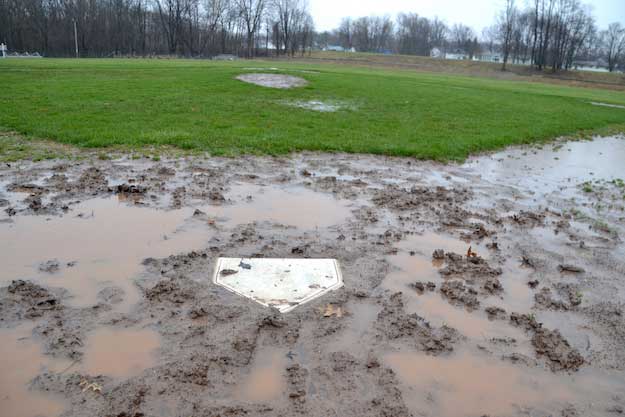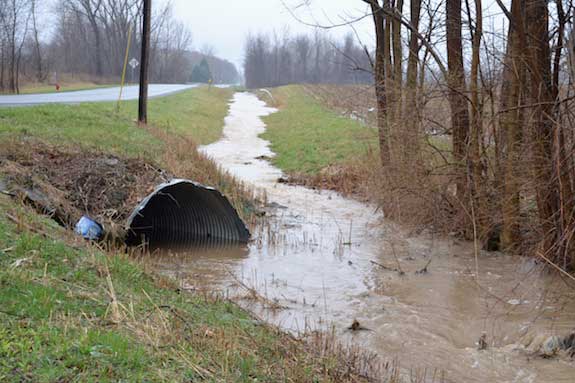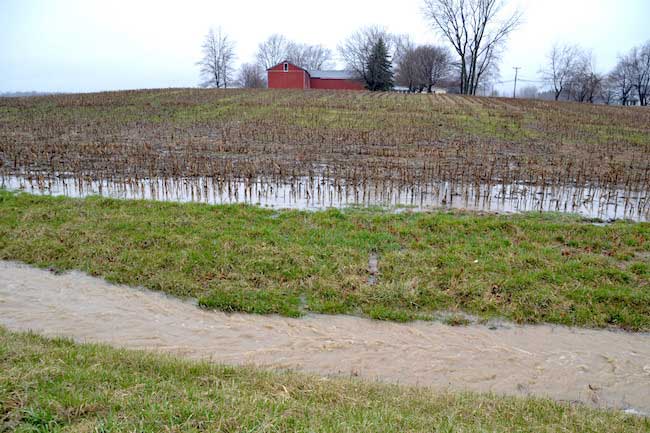Fields, streams are filling with water from heavy rain
Much of state, including Orleans County, under flood watch until Saturday
Orleans County and Western New York have been soaked today and more rain is coming on Friday. The region remains under a flood watch until 2 p.m. Saturday. About 2.5 inches of rain is expected over the two days.
Governor Andrew M. Cuomo has directed state agencies to prepare for flooding issues throughout the state and urged all New Yorkers to take actions to ensure that they are ready for heavy rains, which will begin today and continue through Friday.
Rain will be heavy at times, and the combination of snowmelt and heavy rainfall could cause moderate flooding to already swollen rivers and streams, low lying areas, urban areas, and areas with poor drainage.

The St. Mary’s Athletic Club Little League field on Moore Street in Albion was soaked at about 1:30 this afternoon.
In Western New York, some areas could see one to five inches of snow in the higher elevations as the system moves through the state.
“With heavy rain in the forecast, I am directing state agencies to prepare for potential flooding and I urge New Yorkers to exercise caution and stay safe,” Cuomo said. “New Yorkers should be ready for the possibility of hazardous travel conditions and state agencies will be on alert and be prepared to assist communities across the state if the need arises.”
Governor Cuomo has directed the Division of Homeland Security and Emergency Services’ Office of Emergency Management and Office of Fire Prevention and Control, the Department of Environmental Conservation, New York State Police, New York State Parks, and other state agencies to prepare staff, assets and stockpiles to support response efforts that may arise during the current flood watches and warnings across the state. The State Watch Center and Emergency Operations Center began to operate in enhanced monitoring at 8 a.m. today.
Governor Cuomo urged New Yorkers to pay special attention to the following safety information:
Flood Safety Preparedness
• Learn the safest route from your home or business to high, safe ground should you have to leave in a hurry. Develop and practice a family escape plan and identify a meeting place if family members become separated.
• Program emergency numbers into the phones of each household member.
• Make an itemized list – as well as potential photo and video documentation — of all valuables, including furnishings, clothing, and other personal property. Keep the list in a safe place.
• Stockpile emergency supplies of canned food, medicine, first aid supplies, and drinking water. Store drinking water in clean, closed containers.
• Have a plan for your pets.
• Have a portable radio, flashlights, extra batteries, and emergency cooking equipment available.
• Keep your automobile fueled. If electric power is cut off, gasoline stations may not be able to pump fuel for several days. Have a small disaster supply kit in the trunk of your car.
• Find out how the location of your property relates to possible flood levels. When predicted flood levels are broadcast, you can determine if you may be flooded.
• Keep materials like sandbags, plywood, plastic sheeting, and lumber handy for emergency water-proofing.
• Check your insurance coverage. Homeowners’ insurance policies generally do not cover flood damages. Only flood insurance can protect your home against flood damages. You can purchase flood insurance whether or not you live in a mapped flood zone.

The drainage ditches move water along Brown Road in Gaines.
Travel Precautions during a Flood
During flash flooding, your vehicle can be the biggest danger. The Centers for Disease Control and Prevention report that over half of all flood-related drownings occur when a vehicle is driven into hazardous flood water.
• Do not attempt to drive over a flooded road. Turn around and go another way.
• Driving through 6 inches of standing water can cause cars to lose control and stall.
• Do not underestimate the destructive power of fast-moving water. A foot of rushing water can carry away a small car and it takes just two feet of fast-moving flood water to carry away most vehicles including SUVs and pick-up trucks. Water moving at two miles per hour can sweep cars off a road or bridge.
• Watch for areas where rivers or streams may suddenly rise and flood, such as highway dips, bridges, and low areas.
• If you are in your car and water begins to rise rapidly around you, abandon the vehicle immediately.






































































